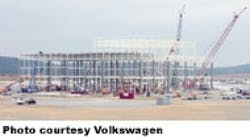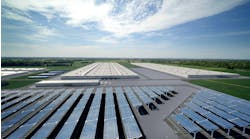In Search Of America's Best Manufacturing Locations
Let's talk location.
Specifically, let's discuss where is the best place to build new manufacturing facilities in the United States. It may seem to be the wrong question to ask in the midst of recessionary doldrums, but in fact, the timing is possibly just right.
Why is that? As Edward W. Hill points out, enormous changes are under way in many manufacturing and related sectors right now. That includes a vast restructuring of the automobile industry and home building, as well as fundamental changes to the materials and energy industries.
"It isn't often that you get that much change going on either in terms of consumer demand or industry structure, or the basic products themselves," says Hill, dean of the Maxine Goodman Levin College of Urban Affairs at Cleveland State University. "If you look back, whole industries tend to pop out of recessions."
The focus on renewable energies is readily apparent in site location announcements by companies such as Nordex USA, which announced in July plans to build a wind turbine manufacturing plant in Jonesboro, Ark., and Siemens AG, which also is building a wind turbine production facility, but in Hutchinson, Kansas.
Add to that International WoodFuels, which announced plans to build a biomass manufacturing plant in Burnham, Maine. In other industries, GlobalFoundries recently broke ground on the construction of Fab 2, a $4.2 billion semiconductor manufacturing facility rising in Saratoga County, New York; Volkswagen is constructing an automotive production facility in Chattanooga, Tenn., and physical fitness equipment maker Precor is building a manufacturing plant in Greensboro, N.C.
None of this information appears to answer the question: Where is the best manufacturing location in the United States? But in fact, it does, sort of. Site location experts say the best location depends on what you're making.
"There's no one location that's good for all manufacturing because manufacturing is so diverse," Hill says. He is seconded by Michelle Comerford, senior location consultant for Austin Consulting. "Different types of manufacturing operations have different requirements, and depending upon the importance of each requirement, different areas are going to be more favorable than others."
Volkswagen Group of America selected Chattanooga, Tenn., as the site for a U.S. automotive facility following a rigorous site-selection process that narrowed its search to Alabama, Michigan and Tennessee. Production at the plant is expected to begin in 2011.
Consider solar energy, for example. One site location expert suggests that solar's development generally follows the path forged by the microelectronics industry in the late 1970s and early 1980s. Both rely on many of the same support functions and skills, so solar energy is likely to find hospitable environments in those same locations. However, the labor expertise required by biopharmaceutical firms, for example, may have those site selectors looking in very different locations.
Choosing Chattanooga
For Volkswagen, the formal site-selection process that ultimately led the automaker to choose Chattanooga took about nine months. A large cross-functional internal team from both Germany and the Americas group drove the site evaluation, augmented by outside advisers that included the Staubach Co. (now Jones Lang LaSalle) and legal advisors.
The company initially applied several high-level filters to narrow its search, according to David Geanacopoulos, executive vice president and general counsel, Volkswagen Group of America. The filters included proximity to infrastructure; the availability of a site of sufficient size (about 1,500 acres); the availability of a site that could be prepared to Volkswagen's aggressive timetable (the desire is to start production in late 2011); and a turnkey site from an ownership perspective. The company did not want contingencies slowing down the site-selection process.
The high-level filter narrowed possible sites to about a dozen, at which time Volkswagen began looking at criteria beyond the actual site characteristics, such as labor force, supplier availability, the proximity of education and health-care institutions, as well as the availability of services needed to operate the plant once it was up and running.
Three finalist sites were selected, in Michigan, Alabama and Tennessee. It was then Volkswagen engaged in competitive negotiations with the appropriate governing authorities to discuss such things as co-investment, taxation issues, infrastructure needs and incentives (although preliminary incentives had been solicited earlier in the process, according to Geanacopoulos).
'Absolute Readiness of the Site'
"In the end there was a combination of financial and incentive factors, but also largely physical factors like the absolute readiness of the site and the confidence we had that we could get the project online on our timetable," Geanacopoulos said. "And in the case of Tennessee, there had been a very substantial amount of early investment by the state, the county and the city in the site itself. They were aggressively working to prepare the site even before we made our decision."
For fitness equipment maker Precor, other factors came into play in its decision to locate a new manufacturing facility in North Carolina. Growing demand prompted a need for more space, yet the company's two existing sites -- one in California and the other in Washington state -- were not large enough to handle an expansion.
"To get the building size we needed in California and still qualify for any grants from the state would have required moving to a location beyond where our existing workforce currently resides. This helped provide the impetus for looking beyond California," a Precor spokesperson said.
GlobalFoundries officially broke ground in July on Fab 2, a $4.2 billion semiconductor manufacturing facility located at the Luther Forest Technology Campus in Saratoga County, New York.
The West Coast locations of its current operations also factored into the decision to go east. "We recognized that having manufacturing and distribution on the Eastern seaboard could be an advantage," the spokesperson said.
Precor's $26.2 million investment in a new Greensboro facility is augmented by a $142,000 state grant.
Criteria to Consider
Typical criteria for manufacturing site selection include a laundry list of factors, such as ready sites, adequate infrastructure, labor availability and costs, training resources, customer location, supplier location, tax policies and incentives.
Austin Consulting's Comerford says, "The first thing a manufacturer should do when considering a new facility location is to define the proposed operation -- everything from raw materials sourcing locations and transportation requirements to the number and types of labor required to the electric power demand and consumption estimates to the desired community characteristics -- all these things should first be defined before evaluating any new locations."
But other factors may apply. "We forget about the impact of product cycle in site location. For sunrise industries, it really is the location of the skilled talent they need to develop their product and deal with rapid model cycles. So they keep them in high-skilled areas. That's kind of the secret of Silicon Valley," Hill says. "Once the model cycle slows down and the product cycle ages and gets more mature, industries are going to be more motivated by the cost profile of places."
Hill names customer location as one of the top three factors in site selection. And for new energy technologies, the location of the end user is more important than it is for fossil fuel producers. Traditionally, energy has been produced closer to the fossil fuel location than to the end user due to transportation costs, Hill notes.
For renewable energy technologies, "Companies are going to launch in areas where the engineering talent is there to invent or refine them. And because a lot of these [technologies] are big and heavy, they're going to be close to where the end user of the energy is," he says.
The Incentives Imperative
Incentives are important. In many instances it is a tie-breaker in the site-selection process, says Hill. But, while incentives may be top of mind for manufacturers looking to locate a plant in the United States, don't let their lure overwhelm your thinking, suggest several site selection experts.
"You really ought not to consider incentives until you get down to drawing fine distinctions between and among semifinalist locations. That's where they come into play," says David Brandon, senior vice president, Site Selection Group, leading the industrial and logistics practice. "However, it's been my experience in the last several years that some of the first words out of our clients' mouths involve incentives. And today, with the federal stimulus program offering a scale of incentives for many types of operations heretofore not experienced in this country, incentives have taken on an even larger role, at least in the thinking of many business people who are tasked with the responsibility to site a new facility."
That said, Brandon says his firm tries to minimize the influence of incentives, for several reasons. Among them, "You've got to live in this community for the rest of this plant's life, and incentives ultimately go away. So you need to find an environment wherein you have the optimum operating conditions for your business in the strategic view -- in the longer term," he says. "It just does not make sense to look at incentives on the front end because they will not overcome disadvantageous operating environments in communities in the longer term."
Volkswagen's Geanacopoulos offers another perspective. He suggests the incentives process is important "not only as a question of financial value but as a question of partnership and commitment and [the] relationship" a company can expect from the community in which it locates.





